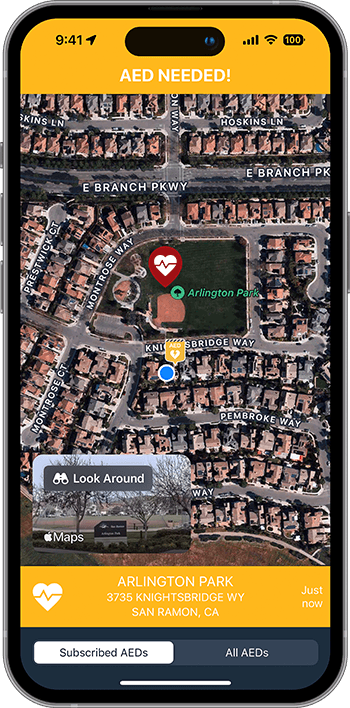
November 27, 2023 | by Admin
911-initiated AED Response: Would you be willing to bring your AED to someone nearby experiencing a cardiac arrest?

In 2020, the American Heart Association began recommending the use of mobile phone technology by emergency dispatch systems to summon willing bystanders to events nearby that might require CPR or AED use. The success of systems like PulsePoint in the United States, Heartrunner in Demark, and GoodSam in the UK prompted this guideline revision. These systems recruit trained individuals to respond to nearby cardiac arrest events and begin the chain of survival earlier and more often.
Now, emergency AED registries are informing dispatchers of AEDs near reported cardiac arrest events. Similar to providing cardiopulmonary resuscitation instruction (T-CPR), equipping call takers with AED locations (T-AED) allows telecommunicators to inform callers of nearby defibrillators. Leading emergency medical dispatch (EMD) and tactical map suppliers have integrated AED locations into their standard pre-arrival instructions, significantly reducing the effort required to incorporate AED locations into call-taking workflows. While today, it’s considered a best practice for emergency dispatchers to provide CPR instructions to callers reporting unconscious/unresponsive victims, recommending nearby AEDs is the natural next step in expediting the chain of survival.
While AED registries have traditionally been used to meet regulatory requirements, the growing use of purpose-built, time-of-need emergency AED registries offers meaningful new opportunities to increase lifesaving AED deployment. In addition to T-AED initiatives, communities are going further by using their registries to alert AED owners and program volunteers to nearby cardiac arrest events. In The Villages® (Sumter County, FL), residents use PulsePoint AED-needed alerts for immediate awareness of neighbors needing defibrillators. The new program allows residents to subscribe to specific AEDs and receive “needed nearby” notifications when a suspected cardiac arrest is reported to 911. According to Stephen Kennedy, Assistant County Administrator for Sumter County, “the system decentralizes program management by moving more capabilities to those directly responsible for individual AEDs. Notifying responders using this method has streamlined our process and allowed our community-based residential AED initiative to scale much faster.” AED-needed alerts work with registered AEDs of any make or model.
Communities have been placing AEDs in public places for more than 30 years, but according to the CARES 2022 Annual Report, only 11.3% of patients who experienced cardiac arrest in public received assistance from a bystander with an AED. This gap highlights the need for innovation and the application of new capabilities to enhance our public AED network. Emergency AED registries that inform and empower dispatch center staff, as well as alert individuals with an AED nearby, offer new hope for improved outcomes and novel approaches to investigate.
If you’re attending the Cardiac Arrest Survival Summit (CASS) from November 29 to December 2 in San Diego we’d love to connect! To learn more about this topic, attend the CASS AED registry session at 10:35 a.m. on Friday or visit the PulsePoint booth (#112) on the exhibit floor. You can also download the Emergency AED Registry factsheet or contact us at info@pulsepoint.org for more information.
PulsePoint is a public 501c3 non-profit foundation.
Filed Under: News, Event, Highlights | Tagged With: AED, 911-initiated AED, AED Alert, AED Response, AED Registry, AED Locator, AED Locations, AED Awareness, AED Registration, AED Registry for dispatchers, 911 AED, 911 AED Registry, EMD AED Registry, Emergency AED Registry, American Heart Association, AED Use, Heartrunner, GoodSam, cardiac arrest, Chain of survival, T-CPR, T-AED, EMD, Emergency Medical Dispatcher, Defibrillator Registry, Defibrillator, Integrated AED Locations, Pre-arrival Instructions, Emergency Telecommunicators, Emergency Dispatchers, CPR instructions, Recommending nearby AEDs, The Villages, Sumter County, AED Subscription, Stephen Kennedy, Residential AED, CARES, CARES Registry, Cardiac Arrest Registry to Enhance Survival, Cardiac Arrest Survival Summit, Community AED Volunteer, AED Responder